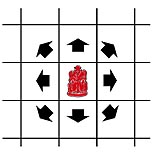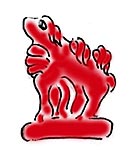How to Play Mongolian Chess
Shatar
Download a free rule booklet ------
Shop
for a playing set
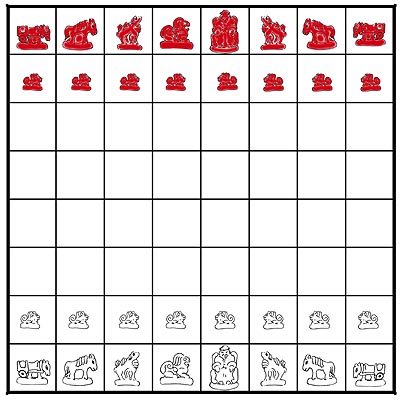
It was probably during the 13th century raids against the Arabs that the Mongols first adopted the game of chess. The Mongol game, Shatar, takes its name from the Arabic Shatranj. Since that time, Mongolian chess has followed a unique pattern of evolution, mixing ancient, modern and characteristically Mongolian influences. The Pieces |
   |
The Shatar playing pieces show an unusual degree of artistic originality. The piece which corresponds to our chess king – Noyon – is usually depicted by a prince seated on a throne. But the queen – Bers, meaning “snow panther” – may be depicted as a mythical lion, a tiger, a snow panther or a bull. The piece corresponding to the western bishop is a two-humped camel – Teme. And the piece corresponding to our knight is, not surprisingly, a horse – Mori. But a great deal of creative latitude is given to depiction of the Mongol rook – Tereg, which means “cart.” This piece may be represented by a horse-drawn cart, a portable tent, a cart wheel, a karmic wheel, an Asian swastika, a yin-yang symbol, a truck, an automobile, or even a bunch of flowers or peacock feathers. The pawn – Fu, meaning “child” – is always smaller than the other pieces, and it can look like just about anything. It can be a smaller mythic lion, a soldier, a smaller horse, a chicken, a rabbit, or just about any small person or animal. | 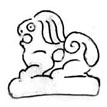 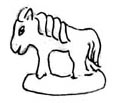 
|
|
The
King (Noyon) moves one space in any direction. |
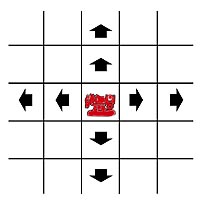 |
The Rook (Tereg) moves as many squares as it wishes forward, backward, left or right until it reaches another piece or the end of the board. Exactly like our western rook. |
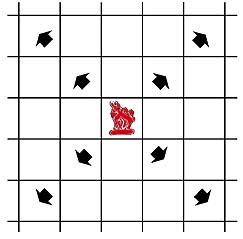
|
The Bishop (Teme) moves just like our western bishop: any number of squares diagonally, as long as its path is clear of other pieces. |
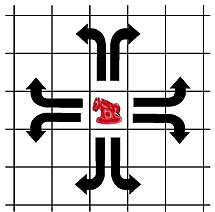 |
The Knight (Mori) also moves like its western counterpart: two spaces forward, backward, right or left, plus one square at a right angle. It can not be blocked by another piece. |
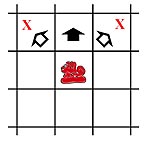 |
The move of the Pawn (Fu) is like that of the ancient pawn. It moves one square forward when not capturing, but captures by moving one square forward/diagonally. Unlike the modern western pawn, it has no option of moving two squares on its first move – except in the opening move of the game (described below). When the pawn reaches the far end of the board it promotes, becoming a Queen (Bers). |
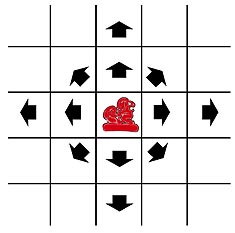 |
The Queen (Bers) has a move very rarely seen in the wide world of chess. It may move like a rook, as far as it likes along any clear path, forward, backward, left or right. Or it may move like a king, one space in any direction. |
How the Game is Played The pieces are arranged as shown above, in the same configuration as modern western chess. The two kings must face each other directly across the board. Either player may make the first move. The first player must start by moving the pawn which stands in front of his queen forward two spaces, and the second player must reply by doing the same, so that the two queen pawns face each other. After that initial mandatory opening, the players take turns, alternately moving one piece at a time. Winning the Game The game is won, as in other forms of chess, by putting the opposing king into a position of being threatened with capture (check), and unable to move to safety – checkmate (Mongolian: Mat). However, in Shatar, some very peculiar restrictions apply: When the king is threatened by a queen, rook or knight, it is called Shak. When threatened by a bishop, it is called Tuk; and when threatened by a pawn, it is called Tsod. These all correspond to what we call “check,” and the threatened player is obliged to move so that his King is no longer under attack. But in order to win the game, the attacking player must use Shak (check by queen, rook or knight), either in the final checkmating move, or in the series of checks that leads directly to checkmate. To make matters more peculiar, the final move, which delivers checkmate, can not be made by a knight – or the game is drawn. Drawing the Game There are a few ways
the game can end with no winner:
|
Download a free rule booklet ------ Shop for a playing set
HOME
PAGE CHESS PRODUCTS: International | Asian | Reproductions | Unique | Rare | Other Games CHESS HISTORY PAGES: 1 | 2 | 3 | 4 | 5 | 6 | 7 | 8 | 9 | 10 HOW TO PLAY: Chess | Courier Chess | Sittuyin | Xiangqi | Shogi | Shatranj | Janggi Makruk | Shatar | Dou Shou Qi | Luzhanqi LINKS: Chess Variants | Chess History | Chess Articles | Mah Jongg AFFILIATED SITES: Rick Knowlton | Courier Chess | Knowlton Mosaics Ken Knowlton | Insite Age | VerySpecial.us CONTACT US |
